There are the three fundamentals components that are supported by data warehouse as shown in figure. These are:
• Load Manager
• Warehouse Manager
• Data Access Manger
We’ll be covering the following topics in this tutorial:
Load Manager
Load Manager Component of data warehouse is responsible for collection of data from operational system and converts them into usable form for the users. This component is responsible for importing and exporting data from operational systems. This component includes all of the programs and applications interfaces that are responsible for pooling the data out of the operational system, preparing it, loading it into warehouse itself it performs the following tasks:
• Identification of data.
• Validation of data about the accuracy.
• Extraction of data from original source.
• Cleansing of data by eliminating meaningless values and making it usable.
• Data formatting.
• Data standardization by getting them into a consistent form.
• Data merging by taking data from different sources and consolidating into one place.
• Establishing referential integrity.
Warehouse Manager

The warehouse manager is the center of data-warehousing system and is the data warehouse itself. It is a large, physical database that holds a vast am6unt of information from a wide variety of sources. The data within the data warehouse is organized such that it becomes easy to find, use and update frequently from its sources.
Query Manager
Query Manager Component provides the end-users with access to the stored warehouse information through the use of specialized end-user tools. Data mining access tools have various categories such as query and reporting, on-line analytical processing (OLAP), statistics, data discovery and graphical and geographical information systems.
 Dinesh Thakur holds an B.C.A, MCDBA, MCSD certifications. Dinesh authors the hugely popular
Dinesh Thakur holds an B.C.A, MCDBA, MCSD certifications. Dinesh authors the hugely popular